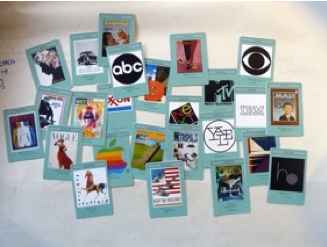December 9, 2013 Playing Games for the Grade
Note: This story first appeared on the School of Art’s website.

Students in “The Idea of Design” are playing games for their grades. The Design(er) METAgame was designed by Professor Cary Staples to help students search for the right question, rather than collect the right answer. The game took two years to evolve to the point in which it is now used regularly in her design survey class. “When I put myself in the students shoes, I understood that they were trying to meet my expectations. They wanted to know what I, as the teacher, wanted from them. My frustration was that I needed them to ask their own questions. To develop their own database of references that they would need as a resource as they progressed through the sequence of design classes. They needed to develop an ongoing strategy to make connections, not just remember the connections that I made. I realized I had to create a framework to allow them to play.” A framework that Professor Staples has presented at several national conferences this year: DiGRA, Digital Games Research Association; at GLS 9.0, Games + Learning + Society; at AIGA, The American Association of Graphic Artists National Conference and the upcoming CAA, College Arts Association, conference in February.
The initial idea came from a workshop offered by the University of Tennessee Teaching and Learning Center, where the methods of a “flipped” classroom—where lectures are given outside of class through video and class time becomes a hands-on experience—were first introduced to Professor Staples. Later that year she attended a gaming conference and was introduced to the concept of a “META game;” a card game about video games designed to facilitate interaction in large groups developed by Colleen Macklin, John Sharp and Eric Zimmerman of Local No. 12 in NYC. This served as inspiration for the first version of the Design(er) METAgame which was formed and first played over the Summer of 2012. “The students who played the game appeared to be more prepared for upper division work in the design sequence, so the game continued, with modifications into the Spring semester class as well.”
The game provides a clear structure from which students can experiment. To play the game, students are first given all of the questions at the beginning of the semester. Questions contain elements of concept development, composition strategies and use of materials to enhance meaning. The students are then asked to consider the questions throughout the term as they explore required readings, both historical and contemporary. Instead of writing responses to the questions, students collect examples of images that they feel they can use to illustrate their responses to questions when they are posed in a debate. The questions remain constant, the fundamental nature of the problems and concepts used to solve them can be identified and allow students to trace strategies across time.

One of the new aspects of the game that has developed to accommodate the larger enrollment of the spring semester class, is the introduction of a tournament. Ader competing all of the readings, players “battle” to move forward in a single elimination style tournament. However, instead of the non-winning player being ejected, s/he becomes a consultant and his/her cards becoming part of the combined teams database. All players and cards may be consulted as the “champion” progresses in the tournament. One aspect of the game that is always part of the discussion is how the judging works. Everyone in class takes a turn being the judge and all participants must agree as to whether the best example wins the match, or the best argument or defense wins the match. Frequently students will find themselves faced with a question to which they have not planned an obvious response. Students work together to resolve how these situations will be evaluated.
According to Staples, “We are attempting to create an environment that fosters ‘Gracious Professionalism,’ a term coined by Dr. Woodie Flowers, FIRST National Advisor and Pappalardo Professor of Mechanical Engineering at the Massachusetts Institute of Technology.” Per Professor Flowers, Gracious Professionalism “is a way of doing things that encourages high-quality work, emphasizes the value of others, and respects individuals and the community. With Gracious Professionalism, fierce competition and mutual gain are not separate notions. Gracious professionals learn and compete like crazy, but treat one another with respect and kindness in the process. They avoid treating anyone like losers. No chest thumping tough talk, but no sticky-sweet platitudes either. Knowledge, competition, and empathy are comfortably blended. In the long run, Gracious Professionalism is part of pursuing a meaningful life. One can add to society and enjoy the satisfaction of knowing one has acted with integrity and sensitivity.”



